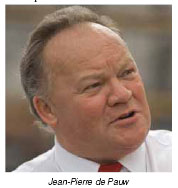
With the opening of its FreightGate 5 terminal in March, Dubai monopoly handler Dnata Cargo fi nally has some room to breathe, with pressure being relieved on the long-suffering original Dubai Cargo Village facility, now knownas FreightGate 1.
Formerly known as the third phase of the Freezone Logistics Centre, FreightGate 5 is a fully-automated terminal capable of handling 350,000 tonnes of cargo, situated on the opposite side of the runways from theoriginal Dubai Cargo Village.
It opened a little behind schedule– it was originally due to be operationalin February, but in fact was fi nally readyon 11 May, after some last minutebuilding delays – but Dnata has actedswiftly since to re-organise its handlingbusiness to make best use of the newcapacity.
Jean-Pierre de Pauw, the handler’s senior vice president cargo, reports that as planned, carriers with both passenger and freighter services via Dubai– including all the major Asian airlines– have been moved to the new facility,where they will be close to the freighterparking positions. The terminal is alsohandling the cargo operations of thepassenger carriers serving Dubai’s passengerterminal two, which is adjacentto FreightGate 5 on the north side ofthe airport.
That leaves FreightGate 1 handling the pure belly cargo operators, and splits the bulk of Dnata Cargo’s 535,000 tonnes of annual freight volumes about equally between the two facilities. The handler also continues to operate FreightGates 3 and 4 on the north side of the airport – the two original phases of the Freezone Logistics Centre, which offer a basic low-cost handling solutionfor all-cargo airlines.
In tandem with the opening of FreightGate 5, Dnata had planned to launch a new pick-up and delivery service called DTD (Door to Door) so that forwarders would not have to deliver cargo to two different sides ofthe airport.
 However, de Pauw says it is still waiting for Customs to agree on a workable procedure. He admits that this is”something of a setback” for agents, butsays discussions with Customs continue.”We are hopeful that something willbe agreed after the summer months,”he says.
However, de Pauw says it is still waiting for Customs to agree on a workable procedure. He admits that this is”something of a setback” for agents, butsays discussions with Customs continue.”We are hopeful that something willbe agreed after the summer months,”he says.
Also delayed is the launch of CALOGI, an ambitious new web portal being developed by Dnata that would enable forwarders to prepare and send documents electronically, make capacity bookings, buy and sell services such as trucking, track and trace shipments, and make payments electronically. Initially aimed at the Dubai market, de Pauw hopes this will become a glo-bal electronic system for the air cargo industry.
 But it is taking longer than expected to programme, he admits. Phase one of this was supposed to be launched in March, but he says it will now be towards the end of the year before it is ready. “We have had 25 programmers working full time on this, but they still can’t write it as fast as we would have liked,” he says. “But we think we have something big here, and we want to make sure it is done properly.”
But it is taking longer than expected to programme, he admits. Phase one of this was supposed to be launched in March, but he says it will now be towards the end of the year before it is ready. “We have had 25 programmers working full time on this, but they still can’t write it as fast as we would have liked,” he says. “But we think we have something big here, and we want to make sure it is done properly.”
FreightGate 1 will now be giving some enhanced x-ray equipment, but otherwise de Pauw says no particular programme of upgrades is planned for the facility. Instead, the focus is turning to FreightGate 7, Dnata’s planned cargo terminal at the new Jebel Ali airport: work on this is due to start later in the year. – Peter Conway









